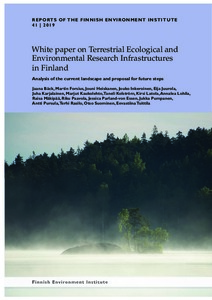White paper on Terrestrial Ecological and Environmental Research Infrastructures in Finland: Analysis of the current landscape and proposal for future steps
Jaana Bäck; Martin Forsius; Jouni Heiskanen; Jouko Inkeroinen; Eija Juurola; Juha Karjalainen; Marjut Kaukolehto; Taneli Kolström; Kirsi Latola; Annalea Lohila; Raisa Mäkipää; Riku Paavola; Jessica Parland-von Essen; Jukka Pumpanen; Antti Pursula; Terhi Rasilo; Otso Suominen; Eevastiina Tuittila
https://urn.fi/URN:NBN:fi-fe2021042825224
Tiivistelmä
This White Paper presents a vision of globally leading, scientifically important and socially relevant
environmental research infrastructures (RIs) in Finland, and identifies what we consider as the key issues to be developed to improve the impact and to support the Finnish national infrastructures in their
international visibility. The focus is on: 1. The scientific questions driving the terrestrial ecosystem and
environmental research globally and in Finland; 2. Specific requirements by different user groups in
Finland for ecological and environmental RIs; and 3. Roadmap for the sustainable ecological and environmental RI in Finland. We also present the strategies of organizations regarding their RI development,
and the existing infrastructures and networks which form the basis for future development. The final
goal of this document is to encourage the development of a coherent vision at national level, and to increase the scientific significance, national synergies and benefits towards a stronger research community.
The need for developing a national RI strategy for environmental field arises from the global challenges, which threaten the ecosystems’ functioning. Human activities are imposing many identified, but
also previously unknown pressures to ecosystem properties and functions, which are also feeding back
to the societies via the quality and quantity of ecosystem services. However, the ecosystem responses to
changes in environment are in many cases poorly quantified and the studies only cover short time
scales. In order to succeed in providing answers to the grand challenges (ICSU 2010), integrated research infrastructures and efficient analysis tools are crucially needed. The request to improve our
knowledge of the state of the environment and the complex biosphere-hydrosphere-atmosphere interactions, and to detect and analyze the impact of global change on these systems has been recognized as a
general priority in developing environmental research infrastructures in EU and globally.
Currently, Finland is one of the world leaders in atmospheric and environmental sciences, both in
terms of research and in coordinating the European and global observation station networks and infrastructures. With this existing experience from close-by research fields and the high research outputs
from ecology and ecophysiology in our research organizations, Finland has also the potential to actively
promote the ecosystem RI concept, and to act as an example of integrated RIs for other countries. The
vision is to develop the capacity of the Finnish ecosystem research community to integrate, upscale and
synthesize the observations with relevant holistic process understanding as well as open and reliable
data management practices. This can be implemented by creating functional and cost-efficient in-situ
platforms and by providing quality-checked data in findable, accessible, interoperable and reusable
(FAIR) manner for high-level environmental research.
This White paper was made in connection with the INAR Ecosystems initiative funded by Academy of Finland and updated with proceeding of European processes, and it provides a starting point for
national cooperation in environmental research infrastructures.
Keywords: Terrestrial ecosystems, research infrastructures, ESFRI
Kokoelmat
- Rinnakkaistallenteet [27094]
